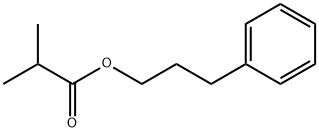BD8367647
3-Phenylpropylisobutyrate , 95+% , 103-58-2
Synonym(s):
3-Phenylpropyl 2-methylpropanoate;Hydrocinnamyl isobutyrate
CAS NO.:103-58-2
Empirical Formula: C13H18O2
Molecular Weight: 206.28
MDL number: MFCD00082227
EINECS: 203-125-0
| Pack Size | Price | Stock | Quantity |
| 25g | RMB152.00 | In Stock |
|
| others | Enquire |
Update time: 2022-07-08
PRODUCT Properties
| Melting point: | -60 °C |
| Boiling point: | 282 °C (lit.) |
| Density | 0.979 g/mL at 25 °C (lit.) |
| FEMA | 2893 | 3-PHENYLPROPYL ISOBUTYRATE |
| refractive index | n |
| Flash point: | >230 °F |
| solubility | Almost insoluble in water, soluble in alcohol and oils |
| form | clear liquid |
| color | Colorless to Almost colorless |
| Odor | Fruity-balsamic, tenacious, but refreshingly sweet odor |
| Odor Type | fruity |
| biological source | synthetic |
| JECFA Number | 640 |
| Cosmetics Ingredients Functions | PERFUMING |
| LogP | 3.75 |
| CAS DataBase Reference | 103-58-2 |
| EPA Substance Registry System | 3-Phenylpropyl isobutyrate (103-58-2) |
Description and Uses
3-Phenylpropyl isobutyrate finds some use in Jasmin compositions, partly as a modifier for Benzyl-isobutyrate, partly as a supporting note for
fruity-balsarnic ingredients. It works well with
Styrax, which tends to produce a rather
"dead" note in floral compositions.
3-Phenylpropyl isobutyrate also finds use in flavor compositions, mainly in imitation Apple, Apricot,
Peach, Pear, Pineapple, Plum, Quince, etc.
and the concentration used is equivalent to
about 1 to 5 ppm in the finished product.
Safety
| Symbol(GHS) |  GHS07 |
| Signal word | Warning |
| Hazard statements | H302-H315-H319-H335 |
| Precautionary statements | P261-P280-P301+P312-P302+P352-P305+P351+P338 |
| Safety Statements | 24/25 |
| WGK Germany | 2 |
| RTECS | NQ5440000 |
| HS Code | 2915.90.2000 |



